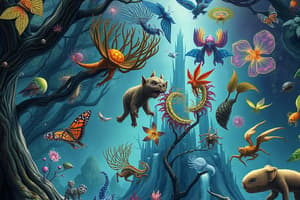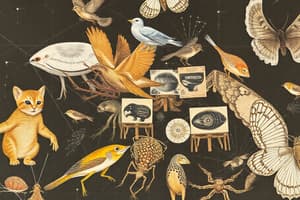Podcast
Questions and Answers
Why do biologists use a classification system to study the diversity of life?
Why do biologists use a classification system to study the diversity of life?
It's easier to keep them organized and study them in a logical way with classification.
The science of classifying organisms and assigning them universally accepted names is known as what?
The science of classifying organisms and assigning them universally accepted names is known as what?
Taxonomy
Why is it confusing to refer to organisms by common names?
Why is it confusing to refer to organisms by common names?
They vary by language and region. It's easier to have one common language.
What is true about binomial nomenclature? (Select all that apply)
What is true about binomial nomenclature? (Select all that apply)
The largest taxonomic category in Linnaeus's system of classification is the ____, and the smallest is the ____.
The largest taxonomic category in Linnaeus's system of classification is the ____, and the smallest is the ____.
How do you remember the order from kingdom to species?
How do you remember the order from kingdom to species?
What traits did Linnaeus consider when classifying organisms?
What traits did Linnaeus consider when classifying organisms?
How do biologists now group organisms into categories?
How do biologists now group organisms into categories?
Characteristics that appear in recent parts of a lineage, but not in its older members, are called what?
Characteristics that appear in recent parts of a lineage, but not in its older members, are called what?
A diagram that shows the evolutionary relationships among a group of organisms is called a(n)?
A diagram that shows the evolutionary relationships among a group of organisms is called a(n)?
Derived characters are used to construct a cladogram.
Derived characters are used to construct a cladogram.
The degree of dissimilarity in DNA sequences is an indication of how long ago two species shared a common ancestor.
The degree of dissimilarity in DNA sequences is an indication of how long ago two species shared a common ancestor.
The scientific view of life was more complex in Linnaeus's time.
The scientific view of life was more complex in Linnaeus's time.
What fundamental traits did Linnaeus use to separate plants from animals?
What fundamental traits did Linnaeus use to separate plants from animals?
Complete the concept map: The six kingdom system.
Complete the concept map: The six kingdom system.
A more inclusive category than any other, including the kingdom, is the?
A more inclusive category than any other, including the kingdom, is the?
List the three domains.
List the three domains.
All members of the domain Bacteria are parasites.
All members of the domain Bacteria are parasites.
Circle the letter of each sentence that is true about members of the domain Archaea. (Select all that apply)
Circle the letter of each sentence that is true about members of the domain Archaea. (Select all that apply)
Taxon composed of similar orders is called?
Taxon composed of similar orders is called?
Taxon composed of similar classes is called?
Taxon composed of similar classes is called?
Kingdom in the Eukarya domain that includes single-celled autotrophs is?
Kingdom in the Eukarya domain that includes single-celled autotrophs is?
Study of evolutionary relationships among organisms is called?
Study of evolutionary relationships among organisms is called?
New taxon that is higher than the kingdom is?
New taxon that is higher than the kingdom is?
Taxon composed of similar genera is called?
Taxon composed of similar genera is called?
Taxon composed of closely related species is called?
Taxon composed of closely related species is called?
General term for any level, or category, in a taxonomic system is?
General term for any level, or category, in a taxonomic system is?
What are prokaryotes?
What are prokaryotes?
What are two different groups of prokaryotes?
What are two different groups of prokaryotes?
What are four characteristics used to identify prokaryotes?
What are four characteristics used to identify prokaryotes?
What are each of the differently shaped prokaryotes called? (Select all that apply)
What are each of the differently shaped prokaryotes called? (Select all that apply)
How do the chemoautotrophs that live near hydrothermal vents on the ocean floor obtain energy?
How do the chemoautotrophs that live near hydrothermal vents on the ocean floor obtain energy?
What are facultative anaerobes?
What are facultative anaerobes?
What occurs in the process of binary fission?
What occurs in the process of binary fission?
What occurs during conjugation?
What occurs during conjugation?
What is an endospore?
What is an endospore?
How do decomposers help the ecosystem recycle nutrients when a tree dies?
How do decomposers help the ecosystem recycle nutrients when a tree dies?
What would happen to plants and animals if decomposers did not recycle nutrients?
What would happen to plants and animals if decomposers did not recycle nutrients?
How can bacteria be used to clean up an oil spill?
How can bacteria be used to clean up an oil spill?
What are viruses?
What are viruses?
What do all viruses have in common?
What do all viruses have in common?
What is the structure of a typical virus?
What is the structure of a typical virus?
A virus's protein coat is called a(n)?
A virus's protein coat is called a(n)?
How does a typical virus get inside a cell?
How does a typical virus get inside a cell?
Why are most viruses highly specific to the cells they infect?
Why are most viruses highly specific to the cells they infect?
Why is a lytic infection given that name?
Why is a lytic infection given that name?
Flowchart about lytic infection: the bacteriophage attaches to the bacterium's _____
Flowchart about lytic infection: the bacteriophage attaches to the bacterium's _____
The bacteriophage injects its ____ into the cell
The bacteriophage injects its ____ into the cell
The cell makes mRNA from the bacteriophage's ____
The cell makes mRNA from the bacteriophage's ____
The virus wrecks the cell, causing it to ____
The virus wrecks the cell, causing it to ____
The bursting of the cell releases new bacteriophage ____
The bursting of the cell releases new bacteriophage ____
Circle the letter of each reason why some biologists do not consider viruses to be alive. (Select all that apply)
Circle the letter of each reason why some biologists do not consider viruses to be alive. (Select all that apply)
What are pathogens?
What are pathogens?
What are the two general ways that bacteria cause disease?
What are the two general ways that bacteria cause disease?
What are antibiotics?
What are antibiotics?
What is one example of a bacterial disease in animals?
What is one example of a bacterial disease in animals?
Why will food stored at low temperatures keep longer?
Why will food stored at low temperatures keep longer?
What are some human diseases that viruses cause?
What are some human diseases that viruses cause?
What is one example of a viral disease in animals?
What is one example of a viral disease in animals?
What is a protist?
What is a protist?
Circle the letter of each sentence that is true about protists. (Select all that apply)
Circle the letter of each sentence that is true about protists. (Select all that apply)
The first eukaryotic organisms on Earth were?
The first eukaryotic organisms on Earth were?
At one time, what were all animallike protists called?
At one time, what were all animallike protists called?
What are pseudopods?
What are pseudopods?
What do sarcodines use pseudopods for?
What do sarcodines use pseudopods for?
The best-known sarcodines are the?
The best-known sarcodines are the?
How do amoebas capture and digest food?
How do amoebas capture and digest food?
What is the indentation on one side of a ciliate into which food is swept called?
What is the indentation on one side of a ciliate into which food is swept called?
What is a contractile vacuole?
What is a contractile vacuole?
What causes malaria?
What causes malaria?
Some animallike protists recycle nutrients by breaking down organic matter.
Some animallike protists recycle nutrients by breaking down organic matter.
Plantlike protists are commonly called?
Plantlike protists are commonly called?
Algae include only multicellular organisms.
Algae include only multicellular organisms.
In the process of photosynthesis, what substances trap the energy of sunlight?
In the process of photosynthesis, what substances trap the energy of sunlight?
Why are algae such a wide range of colors?
Why are algae such a wide range of colors?
How do plantlike protists make much of the diversity of aquatic life possible?
How do plantlike protists make much of the diversity of aquatic life possible?
How can algal bloom be harmful?
How can algal bloom be harmful?
What characteristics do green algae share with plants?
What characteristics do green algae share with plants?
What occurs in the process known as alternation of generations?
What occurs in the process known as alternation of generations?
Why have algae been called the 'grasses' of the sea?
Why have algae been called the 'grasses' of the sea?
Through photosynthesis, algae produce much of the earth's?
Through photosynthesis, algae produce much of the earth's?
What is the compound agar derived from, and how is it used?
What is the compound agar derived from, and how is it used?
How are funguslike protists like fungi?
How are funguslike protists like fungi?
What are slime molds?
What are slime molds?
What is a plasmodium?
What is a plasmodium?
Water molds produce thin filaments known as?
Water molds produce thin filaments known as?
Why aren't there bodies of dead animals and plants littering the woods and fields you walk through?
Why aren't there bodies of dead animals and plants littering the woods and fields you walk through?
What are examples of plant diseases that water molds cause?
What are examples of plant diseases that water molds cause?
Any organism that is not a plant, an animal, a fungus, or a prokaryote is a?
Any organism that is not a plant, an animal, a fungus, or a prokaryote is a?
A temporary cytoplasmic projection used in feeding and movement is called a?
A temporary cytoplasmic projection used in feeding and movement is called a?
The process of switching back and forth between haploid and diploid stages in a life cycle is known as ___ of generations.
The process of switching back and forth between haploid and diploid stages in a life cycle is known as ___ of generations.
Circle the letter of each sentence that is true about fungi. (Select all that apply)
Circle the letter of each sentence that is true about fungi. (Select all that apply)
The cell walls of fungi are made of a complex carbohydrate called?
The cell walls of fungi are made of a complex carbohydrate called?
How do fungi digest their food?
How do fungi digest their food?
What is mycelium?
What is mycelium?
Why is a mycelium well suited to absorb food?
Why is a mycelium well suited to absorb food?
Circle the letter of each sentence that is true about sexual reproduction in fungi. (Select all that apply)
Circle the letter of each sentence that is true about sexual reproduction in fungi. (Select all that apply)
The spores of many fungi scatter easily in the wind.
The spores of many fungi scatter easily in the wind.
For a fungal spore to grow, where must it land?
For a fungal spore to grow, where must it land?
Flashcards are hidden until you start studying
Study Notes
Classification and Taxonomy
- Biologists classify organisms to maintain organization and facilitate logical study of life's diversity.
- Taxonomy is the science of classifying organisms and assigning universally accepted names.
- Common names for organisms can cause confusion due to variations across languages and regions.
- Binomial nomenclature assigns each species a two-part scientific name, which is italicized.
- Linnaeus's classification hierarchy: kingdom is the largest category, and species is the smallest.
Evolutionary Relationships
- Modern classification uses evolutionary relationships (phylogeny) to group organisms.
- Derived characters are traits found in recent lineage members, critical for classification.
- Cladograms visually represent evolutionary relationships among organisms.
Domains and Kingdoms
- The six-kingdom system includes Animalia, Plantae, Protista, Fungi, Eubacteria, and Archaebacteria.
- Domains represent broader categories than kingdoms, with three main domains: Bacteria, Archaea, and Eukarya.
- Archaea members are unicellular but not eukaryotic, and they possess unique characteristics.
Prokaryotes and Their Characteristics
- Prokaryotes are unicellular organisms lacking a nucleus, categorized into eubacteria and archaebacteria.
- Characteristics to identify prokaryotes include shape (bacilli, cocci, spirilla), cell wall composition, mobility, and energy acquisition.
- Binary fission is the process of reproduction in bacteria resulting in identical daughter cells.
- Conjugation involves the transfer of genetic material between bacterial cells through a bridge.
Bacteria and Their Roles
- Decomposers recycle nutrients, aiding ecosystems by breaking down dead matter.
- Bacteria can be used in bioremediation, such as cleaning up oil spills by digesting petroleum.
- Antibiotics block bacterial growth and reproduction, combating diseases such as anthrax.
Viruses
- Viruses are composed of nucleic acid and protein, relying on living cells to replicate.
- All viruses share the ability to enter cells and utilize the host's machinery for replication.
- A virus's capsid is its protective protein coat.
- Lytic infections culminate in the destruction (lysis) of the host cell.
Protists
- Protists are eukaryotic organisms that are neither plants, animals, nor fungi, divided into groups like protozoa and algae.
- Not all protists are unicellular; some can be multicellular with specific characteristics like true nuclei and membrane-bound organelles.
- Plant-like protists, or algae, perform photosynthesis and significantly contribute to aquatic ecosystems' diversity.
Fungi
- Fungi are heterotrophic eukaryotes with cell walls made of chitin and absorb nutrients externally.
- Mycelium, composed of tangled hyphae, increases the surface area for nutrient absorption.
- Fungal reproduction can be sexual or asexual, with spores dispersing easily to inhabit favorable environments.
Summary of Key Concepts
- The study of biological classification emphasizes the need for standardized naming and grouping.
- Understanding the evolutionary relationships among organisms provides insight into biodiversity.
- Prokaryotes and viruses display unique characteristics affecting their roles in ecosystems and human health.
- Protists and fungi play essential functions in ecology, nutrient cycling, and disease dynamics.
Studying That Suits You
Use AI to generate personalized quizzes and flashcards to suit your learning preferences.





